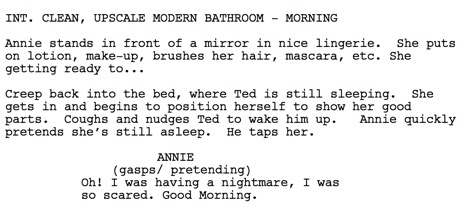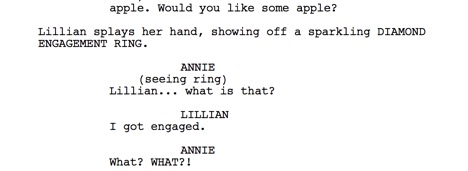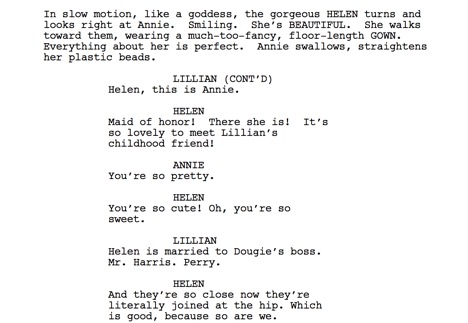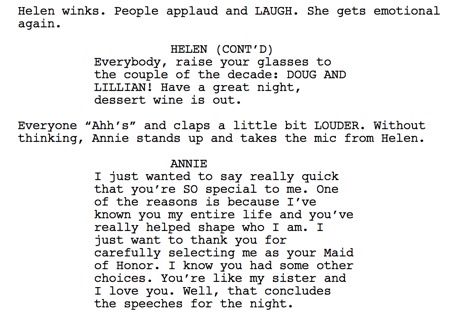Bridesmaids
When Bridesmaids was released in 2011, a lot was riding on its shoulders. Some said the very future of female-driven comedies depended on whether the film landed at the box office. Luckily, it did not disappoint. A firecracker cast and tight script propelled it all the way to the Academy Awards where it was nominated for Best Original Screenplay—something that was not only a significant moment for women-driven films, but for comedies themselves. Critics and award shows tend to gravitate towards the high planes of drama, dismissing comedy as a lower form of entertainment. The overwhelmingly positive critical and commercial reception of Bridesmaids carved out a spot for the comedy—specifically the female-driven comedy—in a space typically dominated by male-driven dramas. It has been one of my favourite films ever since.
The screenplay—penned by Annie Mumolo and Kristen Wiig— is a masterful work of comedic writing. Every scene jumps off the page and manages to be at once heartfelt and hilarious. This makes it a compelling read from start to finish. So what makes this screenplay great? In essence, it is a combination of voice, concise dialogue, perfectly timed beats, and the writers’’ keen eye for absurdity. It takes a world we’ve seen countless times in comedies, romantic comedies, and even dramas—the world of weddings—and turns it on its head.
The opening scene immediately establishes the tone of the piece, helps build the world of this screenplay, and hooks us into the protagonist’s life.

The first line of action “the ultimate bachelor pad” gives this screenplay voice—something I’ve always thought is the best way for a writer to convey tone consistently throughout a screenplay. This isn’t just a nice house. This is the “ultimate bachelor pad.” Right away, we know whoever lives here is a jerk. The O.S. dialogue that follows confirms this.

If brevity is the soul of wit, this is the perfect line of dialogue. Seven words and we know exactly who these characters are and everything about their relationship. Annie is looking for an emotional connection (“I love your eyes”) while Ted is just in this for the sex (“cup my balls.”) In addition to setting up character and establishing relationships, the incongruity between these two lines makes for a hilarious set-up-punchline-style joke.
When we finally see the characters, the scene is a hilarious reversal of the typical romantic comedy sex scene. Instead of passionate lovemaking followed by a heartfelt emotional talk, Annie has bad sex followed by a less-than-dreamy chat with Ted. This is a deft bit of world-building that quickly establishes Bridesmaids as a film meant to poke fun of the chick-flick/rom-com genre, while still adhering to its conventions. In the typical rom-com the female protagonist wakes up flawless, bathed in a pool made of sunlight and her lover’s sweet gaze. Annie, on the other hand, fakes this flawless look and creeps back into bed. This reversal not only makes for a great joke but hints at the type of problems Annie will face throughout this screenplay by revealing her character’s fatal flaw. As we can see in this scene, Annie has a desire to be perfect and lead a perfect life, but is anything and does anything but. This desire to be perfect conflicts her inherently messy personality and poor decisions, which creates conflict and drives the plot forward. Her fatal flaw is what drives Bridesmaids’ A story. She tries to beat Helen for title of “perfect friend” and fails miserably.

When Annie leaves Ted’s house, the script uses physical humour, not only for a laugh but as a metaphor for Annie’s fatal flaw and main conflict.

Here she is described literally straddling a gate. This bit of imagery is a physical manifestation of how Annie’s character is stuck in a rut while everything around is moving and changing. All she can do is hang on and hope to get through it. This is a great example of how imagery in comedies can be a site for both physical humour and meaning.
The next relationship the script sets up is Annie’s relationship with Lillian. This bit of set-up is rendered invisible by the fresh, funny physical comedy of the scene.

Here, we meet Lillian and get a sense of her and Annie’s dynamic as friends. The fact that they are ripping off an exercise class in the middle of a public park tells us these two characters are extremely comfortable around one another and have likely been friends a long time.

The following scene in the restaurant—where they discuss the current state of their lives—confirms this. These women are best friends. This set up not only establishes the most important relationship in the script but gives the screenplay stakes. Lillian is clearly Annie’s best friend— the one good thing in her otherwise disastrous life. Annie can’t lose her—which, of course, is exactly what happens. By setting Lillian up as the most important thing in Annie’s life, the stakes of Annie’s central goal, beating Helen for Lillian’s affection, are raised.
The first twenty pages of this script also handle exposition well. When Lillian and Annie walk past the abandoned Cake Baby bakery together we learn, in one quick scene, that Annie owned a bakery, it went under, and she’s been floundering ever since.

In the next scene, we learn that her boyfriend left her when the bakery shut down via a quick, funny line of dialogue from her current boss.

The words “and how your boyfriend left you” fit seamlessly into this line of dialogue and don’t feel contrived within the context of the scene, which takes place in a jewelry store swarming with couples. This script builds the “before world” of this screenplay quickly and subtly. It sets up relationships and gives us backstory within the first 12 pages then immediately hits us with an inciting incident: Lillian’s engagement to Dougie.

This catalyst beat is strong and arrives early enough in the script to hook the reader into the plot. Thanks to the skillful set-up in the first twelve pages, we know that Lillian is the most important thing in Annie’s life and her engagement will turn Annie’s life upside down and drive the story forwards. We see the emotional impact of Lillian’s news as soon as she leaves Annie alone.

The line of action “Annie is left alone laughing to hard by herself” shows, rather than tells, us exactly how she feels. She wants to be happy for her friend, but it terrified of being abandoned. This catalyst does everything a catalyst should: turn’s the protagonist’s world upside down and catapults her into the antithesis portion of the screenplay.
Next, this script introduces us to the characters who populate this upside down world. It does this in the most efficient way possible: by having them all gather in one location. At Lillian’s engagement party, we are introduced to every major character in this screenplay including the antagonist, or obstacle, that will get in the way of Annie and her goal. This obstacle is Helen, Lillian’s new best friend. When Annie meets Helen, the writers do a fantastic job of crafting dialogue full of tension and subtext.

The action sets Helen and Annie up as opposites. Helen is rich and elegant in a FLOOR LENGTH GOWN, and Annie is nervous and wears PLASTIC BEADS. Differences equal conflict and conflict equals a good screenplay. The stark differences between the two women establish that they will not be friends and, thanks to the description of their characters in the action, their dialogue reads passive aggressive rather than pleasant. Helen’s line “And they’re so close now they’re literally joined at the hip. Which is good, because so are we” is a direct attack on Annie. Having the characters say the opposite of what they mean makes for fun, tension-filled dialogue.

Once we are introduced to the antagonist of the story, the script wastes no time hitting the crucial break in two beat, which happens when Annie and Helen give speeches at Lillian’s engagement party.

Here, we see physically see Annie decide she will compete with Helen for title of “Lillian’s Best Friend.” As soon as she grabs the microphone from Helen and tries to outdo her speech, we have entered act two, which we know will be full of conflict between these two women. Up until the beat, Annie has been a bit of a passive character, but when she takes the microphone from Helen, she becomes an active protagonist. By page twenty-three, Annie has a clear goal (remaining Lillian’s best friend) and a clear obstacle (Helen.) The stakes are high (Lillian is the one good thing in Annie’s life), and there is even a bit of a ticking-clock component to the story (Annie has to achieve her goal by Lillian’s wedding.) Within twenty-three pages, not only does this script contain all the elements of a compelling screenplay, but it makes sure each element has the potential to generate comedic situations throughout the remainder of the script. The engagement party speech scene between Helen and Annie promises act two will be full of similarly hilarious conflict.
According to Blake Snyder’s beat sheet, the B story of should come immediately after the act two break. Bridesmaids adheres to this structure, and its B Story comes into play on page twenty-six when Annie meets Officer Rhodes.

This is a strong example of a B story. Throughout the screenplay, it ties into the theme of the script while providing a break from the central action of the story. It also lends the film gravitas, as it contains little of the over-the-top slapstick style humour of the A story. Instead, it focuses on the thematic and emotional arc of Annie’s character, as she learns to open herself up to new people and embrace change. This emotional arc is important to the A story, as Annie eventually learns that she will have to accept Helen into her life in order to be a good friend to Lillian. When Officer Rhodes confronts Annie on page eighty-seven, he draws attention to her fatal flaw. This acts as a catalyst for Annie’s growth as a character and connects the B story to the A story. In order to win Lillian back, she needs to be more aware of how her actions impact the people around her.

Act two of this screenplay is where the comedy shines. The first twenty pages set up Annie’s goal and obstacle and this set up pays off in act two as Annie comes face to face with Helen in a series of misadventures including a disastrous bridesmaids dress fitting, bachelorette party, and wedding shower. What makes this section great, is the way it shits (literally) all over typical wedding movie tropes. It takes familiar scenes like the “dress fitting,” “bachelorette party” and “wedding shower” and manipulates them for maximum comedic effect. The ladies get food poisoning and destroy the bridal shop; they don’t make it to Vegas because Helen drugs Annie on the plane; and Annie physically destroys everything at the bridal shower in an angry rampage. This technique of taking familiar scenes, images, and characters and flipping them on their heads is something I strive for in my own writing. It is a fantastic way to generate comedy and poke fun of traditions and conventions without treading into satire.
Throughout act two, this screenplay never stops throwing obstacles at its protagonist. Character development happens through Annie’s response to these obstacles and, by the end of act two, we know Annie’s character intimately.
For example, in the bridal shop scene, Annie refuses to admit she has food poisoning. What this action reveals about her character is that she’s proud, determined, and stubborn. Bridesmaids proves that obstacles are the best way reveal a character’ inner workings.
By the end of act two, Annie is defeated. She has alienated almost every one of her friends, lost her job, been kicked out of her apartment, destroyed her relationship with Officer Rhodes and been uninvited to her best friend’s wedding. She is at her rock bottom. This is an ingenious bit of plotting. Having Annie end act two at a low point leaves her with somewhere to go in act three. She has to fix the situation she’s created. This requires her character to take an active role in act three. This active role pushes the plot all the way to the end of the screenplay. In act three she repairs things with Officer Rhodes, makes up with Helen, and patches things up with Lillian. Small obstacles, like Lillian going missing, get in the way of these goals in order to keep act three exciting, but Annie overcomes all of them. The script ends on a high—the opposite of the midpoint—making for a satisfying resolution.
Structurally, Bridesmaids is incredibly strong, but what really makes it really shine is the comedy. Each beat is laced with humour. This marriage between structure, comedy, and voice is what makes Bridesmaids a great screenplay.